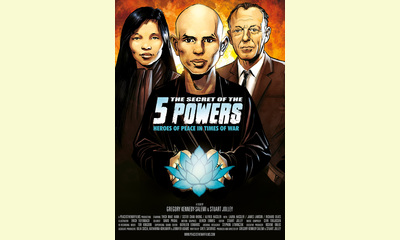|
|
The Secret of the 5 Powers - A documentary about nonviolent heroes
un articulo por Iulia Socea
Video: three nonviolent heroes
The Secret of the 5 Powers tells the true stories
of three remarkably courageous individuals whose
nonviolent action inspired Dr. Martin Luther King,
Jr. and millions of others around the world. The
documentary weaves comic book animation with
contemporary and historic footage that follows the
lives of Alfred Hassler, an American anti-war
hero, Vietnamese peace activist Sister Chan Khong
and Zen Master, Thich Nhat Hanh, whom Dr. King
nominated for the Nobel Peace Prize in 1967. By
cultivating the sacred 5 Powers of Faith,
Diligence, Mindfulness, Concentration, and
Insight, they combatted violence and destruction,
planting seeds of peace in the mud of war.

click on photo to enlarge
The film provides a rare glimpse into the lives of
individuals who continue to have a tremendous
impact on the world. Thich Nhat Hanh and Sister
Chan Khong are among today’s most respected
spiritual leaders, but little is known about their
early struggles and the paths that led them to
take nonviolent action. Alfred Hassler’s memory is
treasured by those who knew and loved him; but his
story has previously never been told. Also largely
unknown is the connection between our three
protagonists and many of the world’s foremost
voices for peace and how their cooperation
continues to affect change that transcends
geographical borders, religion and time.
The film points to the fact that nonviolent
movements are not outside of the realm of violence,
nor out of touch with reality, but are situated
beyond violence, giving practitioners a more
powerful tool than arms and weaponry.
As the film tells a story of the seemingly
unstoppable escalation of violence, it
simultaneously redefines a traditional dramatic
structure: there is no good or bad, no white or
black. There is only compassion and suffering. The
realization of this ultimate truth has the power
to unite us-- each with the other and with all who
have fought for peace. The story ends with a
call to action, an invitation to the viewer to
become a hero in his or her own life.
For more information about this film and the team,
please visit http://ww
w.peaceisthewayfilms.com/ and http://www.peacecomic
s.com/.
|








|
DISCUSSION
Pregunta(s) relacionada(s) al artículo :
Understanding the culture of peace, What are the key videos?
* * * * *
Comentario más reciente:
:
To begin this discussion, here are videos from three people who first developed the culture of peace concept at UNESCO and the United Nations:
Anwarul Chowdhury: Culture of Peace
David Adams: Culture of Peace
Federico Mayor: Culture of Peace
Federico Mayor: Cultura de Paz

|
|









